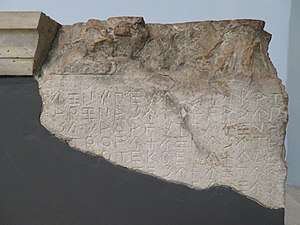Lycian alphabet
The Lycian alphabet was used to write the Lycian language of the Asia Minor region of Lycia. It was an extension of the Greek alphabet, with half a dozen additional letters for sounds not found in Greek. It was largely similar to the Lydian and the Phrygian alphabets.
| Lycian | |
|---|---|
| Type | Alphabet
|
| Languages | Lycian language |
Time period | 500-330 BC |
Parent systems | Phoenician
|
Sister systems | Lydian, Phrygian |
| Direction | Left-to-right |
| ISO 15924 | Lyci, 202 |
Unicode alias | Lycian |
Unicode range | U+10280–U+1029F |

The alphabet
The Lycian alphabet[1][2] contains letters for 29 sounds. Some sounds are represented by more than one symbol, which is considered one "letter". There are six vowel letters, one for each of the four oral vowels of Lycian, and separate letters for two of the four nasal vowels. Nine of the Lycian letters do not appear to derive from the Greek alphabet.
| Lycian letter | Transliteration | IPA | Notes |
|---|---|---|---|
| 𐊀 | a | [a] | |
| 𐊂 | b | [β] | |
| 𐊄 | g | [ɣ] | |
| 𐊅 | d | [ð] | |
| 𐊆 | i | [i], [ĩ] | |
| 𐊇 | w | [w] | |
| 𐊈 | z | [t͡s] | |
| 𐊛 | h | [h] | |
| 𐊉 | θ | [θ] | |
| 𐊊 | j or y | [j] | |
| 𐊋 | k | [kʲ] | [ɡʲ] after nasals |
| 𐊍 | l | [l] and [l̩]~[əl] | |
| 𐊎 | m | [m] | |
| 𐊏 | n | [n] | |
| 𐊒 | u | [u], [ũ] | |
| 𐊓 | p | [p] | [b] after nasals |
| 𐊔 | κ | [k]? [kʲ]? [h(e)] | |
| 𐊕 | r | [r] and [r̩]~[ər] | |
| 𐊖 | s | [s] | |
| 𐊗 | t | [t] | [d] after nasals. ñt is [d] as in 𐊑𐊗𐊁𐊎𐊒𐊜𐊍𐊆𐊅𐊀 / Ñtemuχlida for Greek Δημοκλείδης / Dēmokleídēs.[3] |
| 𐊁 | e | [e] | |
| 𐊙 | ã | [ã] | 𐊍𐊒𐊖𐊙𐊗𐊕𐊀 / Lusãtra for Greek Λύσανδρος / Lúsandros.[4] |
| 𐊚 | ẽ | [ẽ] | |
| 𐊐 | m̃ | [m̩], [əm], [m.] | originally perhaps syllabic [m], later coda [m] |
| 𐊑 | ñ | [n̩], [ən], [n.] | originally perhaps syllabic [n], later coda [n] |
| 𐊘 | τ | [tʷ]? [t͡ʃ]? | |
| 𐊌 | q | [k] | [ɡ] after nasals |
| 𐊃 | β | [k]? [kʷ]? | voiced after nasals |
| 𐊜 | χ | [q] | [ɢ] after nasals |
Unicode
The Lycian alphabet was added to the Unicode Standard in April, 2008 with the release of version 5.1. It is encoded in Plane 1 (Supplementary Multilingual Plane).
The Unicode block for Lycian is U+10280–U+1029F:
| Lycian[1][2] Official Unicode Consortium code chart (PDF) | ||||||||||||||||
| 0 | 1 | 2 | 3 | 4 | 5 | 6 | 7 | 8 | 9 | A | B | C | D | E | F | |
| U+1028x | 𐊀 | 𐊁 | 𐊂 | 𐊃 | 𐊄 | 𐊅 | 𐊆 | 𐊇 | 𐊈 | 𐊉 | 𐊊 | 𐊋 | 𐊌 | 𐊍 | 𐊎 | 𐊏 |
| U+1029x | 𐊐 | 𐊑 | 𐊒 | 𐊓 | 𐊔 | 𐊕 | 𐊖 | 𐊗 | 𐊘 | 𐊙 | 𐊚 | 𐊛 | 𐊜 | |||
| Notes | ||||||||||||||||
See also
Notes
- Adiego (2007) page 764.
- Bryce (1986) pages 56-57.
- Bryce, T. R. (January 1986). "The Pronunciation of Delta in Greek and Lycian". Classical Philology. 81 (1): 56–58. doi:10.1086/366958. JSTOR 269877. First page displayable no charge.
- Bryce (1986) page 58.
References
- Adiego, I. J. (2007). "Greek and Lycian". In Christidis, A. F.; Arapopoulou, Maria; Chriti, Maria (eds.). A History of Ancient Greek From the Beginning to Late Antiquity. Chris Markham (trans.). Cambridge University press. ISBN 0-521-83307-8.. Translator Chris Markham.
- Bryce, Trevor R. (1986). The Lycians - Volume I: The Lycians in Literary and Epigraphic Sources. Copenhagen: Museum Tusculanum Press. ISBN 87-7289-023-1.
- Roger D. Woodard, 2007, The Ancient Languages of Asia Minor.
External links
| Wikimedia Commons has media related to Lycian alphabet. |
- Everson, Michael (2006-02-05). "N3019R2: Proposal to encode the Lycian and Lydian scripts in the SMP of the UCS" (PDF). DKUUG Standardization. Danish Unix User Group (DKUUG). Retrieved 2008-03-18.